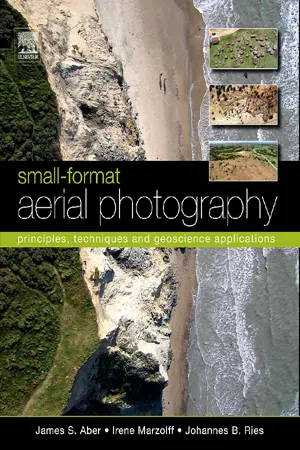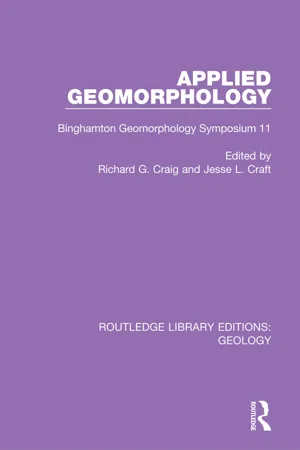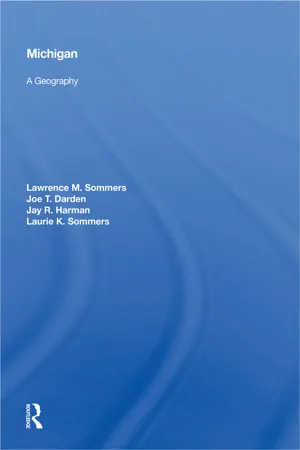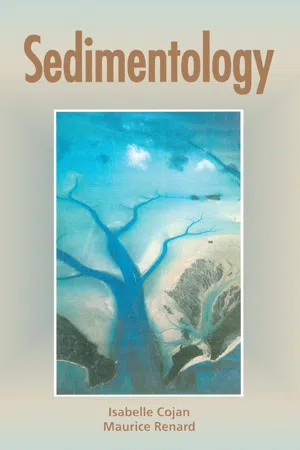Glacial Depositional Landforms
Glacial depositional landforms are features created by the deposition of material by glaciers. These landforms include moraines, drumlins, eskers, and outwash plains. Moraines are ridges of glacial till, while drumlins are elongated hills formed by glacial action. Eskers are long, winding ridges of sand and gravel, and outwash plains are flat areas of sediment deposited by meltwater from glaciers.
6 Key excerpts on "Glacial Depositional Landforms"
- eBook - ePub
- Simon Bell(Author)
- 2012(Publication Date)
- Routledge(Publisher)
...Layered material can also build up inside tunnels within the base of the glacier or ice sheet. When the ice melts these are exposed as linear mounds called eskers. They also follow the direction of ice movement. Sediment washed off the ice surface can form low, irregular ridges like a cockscomb. These are called kames, and may occur in large areas. Although eskers and kames may resemble moraines, they are different, because of their layered structure. Figure 6.28 Drumlins provide the pattern of landform in this part of Ireland (County Mayo).The repeated close-packed structure of rounded landforms creates a small-scale enclosed landscape. As the glaciation period ended, sometimes sheet ice broke up into large blocks that melted slowly and became surrounded by sands or gravels washed over and around them. Once the blocks of ice finally melted they left holes, called kettle holes. These usually fill with water to form small ponds or lakes, many of which eventually fill with aquatic vegetation to become bogs and marshes. Depositional landforms also differ in their hydrological characteristics. The finest powdery or clay-like particles in the moraines can develop very impeded drainage whilst the layered, coarser-textured structures (eskers, kames) can be very well drained. Some larger areas of sandy material washed from the snout of large glaciers, called outwash plains, can dry out sufficiently for wind action to form dune structures. Some of the finest-grained material may also blow away to build up elsewhere as loess deposits. Thus, in mountainous terrain, a complete depositional landscape develops in the lower parts, whereas erosional structures tend to predominate in the higher elevations. This leads to a distinct contrast in patterns between the angular, concave structures high up and the smoother, rounded forms lower down...
- eBook - ePub
Small-Format Aerial Photography
Principles, Techniques and Geoscience Applications
- James S. Aber, Irene Marzolff, Johannes Ries(Authors)
- 2010(Publication Date)
- Elsevier Science(Publisher)
...The results are complex landform assemblages that represent multiple glaciations during the Pleistocene. Aerial photography has long been utilized to illustrate, describe, interpret, and map the diverse types of landforms created by glaciation (e.g. Gravenor et al., 1960). Traditionally this approach is based on medium-scale, panchromatic, vertical airphotos taken from heights of several thousand meters (Fig. 12-2). In recent years, satellite imagery has been utilized increasingly for glacial geomorphology (Williams, 1986). Low-height, oblique airphotos also have proven effective for recognizing and displaying various types of landforms (e.g. Dickenson, 2009), including distinctive glacial landforms such as eskers and drumlins (Prest, 1983). The advantage of oblique views is the ability to visualize the three-dimensional expression of individual landforms within the surrounding terrain (Fig. 12-3). The following small-format aerial photography (SFAP) was acquired with kites and a small helium blimp at formerly glaciated sites across the United States and several countries in northern Europe. All represent landforms created during the last major glaciation in the late Pleistocene, some 10,000 to 25,000 years ago. Because of their young age, the landforms are fresh and well expressed in the landscape. They are grouped according to the main geomorphic process involved in their formation. 12.2. GLACIAL EROSION Glacial valleys and fjords are among the most spectacular examples of combined erosion by glacier ice and meltwater. Such valleys may be 100s to >1000 m deep and extend for 10s to > 100 km in length. They are typically found in mountains or rugged upland areas that were invaded by ice sheets or subjected to local valley glaciation and are especially common where montane glaciers descended into the sea or large lakes. Famous examples include Hardangerfjord, Norway; Konigssee, Germany (Fig...
- eBook - ePub
Applied Geomorphology
Binghamton Geomorphology Symposium 11
- Richard G. Craig, Jesse L. Craft(Authors)
- 2020(Publication Date)
- Routledge(Publisher)
...The first group is characterized by poor infiltration because of underlying till; the second group is basically outwash and alluvial deposits with good infiltration but also having areas where local flooding may occur. The landform derived from slope erosion and mass wasting makes up the third group, and the fourth group is comprised of local dissimilar landforms with varying characteristics. Drumlins, ground moraines, and constructional slope landforms The drumlins, ground moraines, and constructional slopes are landforms underlain by till. Drumlins are found throughout the area but are most obvious in the northeast quarter, where they form elongated islands in Lake Tapps. The drumlins are not “classical” drumlins, with a spoon-shaped form, but instead are long, symmetrical linear features composed of till. The drumlins vary in size from 3 to 33 m high and 0·3 to 2 km long. They are aligned north-south, reflecting the direction of movement of the continental ice. Ground moraine is defined by Flint (1957 p. 131) as a “moraine having low relief devoid of transverse linear elements.” These areas are underlain by till, do not have drumloidal features, lack integrated drainage, and have a slope less than 12%. They contain closed depressions and are usually adjacent to drumloidal landforms. Constructional slopes are landforms underlain by till, are devoid of transverse linear elements, and have slopes of approximately 12 to 40%. Figure 2 Section of landform map with landforms outlined. Gm, ground moraine; Sm, modified slope; Ow, outwash; Ma, modified area; Dr, drumlin; Se, erosional slope; Owvt, outwash valley train; Cs, constructional slope; Vtr, valley train; Esk, esker;_______, contact. (See text for detailed explanation of map units.) Figure 3 Section of landform map...
- eBook - ePub
- Rattan Lal(Author)
- 2017(Publication Date)
- CRC Press(Publisher)
...Each grouping was based on landforms resulting from a set of similar processes or a succession of processes. Similar regional groupings have been produced for the coterminous United States, [ 14, 15, 16 ] and for Alaska. [ 17 ] A genetic classification, or the mode of origin, has some overlap with descriptive systems because different manner of origin may produce different forms. Examples of genetic systems include the classification of volcanic rocks, [ 18 ] the classification of glacial landforms, [ 19, 20 ] and landslide types and processes. [ 21 ] LANDFORM DEVELOPMENT Landforms may be erosional or constructional in form, or a composite of both. Most landforms are the products of erosion, but many are formed by the deposition of sediments, by volcanic activity, or by movements from within the earth’s crust. Examples of depositional features include dunes, moraines, and spits. Examples of erosional features are water gaps, deflation basins, or arêtes. Lahars, lava plains, and volcanoes result from volcanic activity. The formation of many alluvial fans and subsequent episodes of erosion and sedimentation in the basin and range of the Western United States are triggered by tectonic uplift. LANDFORMS AND MAPPING Landforms are part of a continuum of near surface features, soils, and surficial sediments. Bloom [ 22 ] describes a landform in a continuum as a unit of systematic analysis. When mapping, distinctive landform populations need to be delineated. The patterns are identifiable in the field with aids such as topographic maps, aerial photography, geophysical surveys, land use maps, and other available information. Delineating landforms can sometimes simplify soil mapping. For example, in traversing a hillslope from its summit to its toe, one might recognize several differing soil map units...
- eBook - ePub
Michigan
A Geography
- Lawrence M. Sommers(Author)
- 2019(Publication Date)
- Routledge(Publisher)
...(Source: Adapted from Lawrence M. Sommers, ed., Atlas of Michigan [East Lansing: Michigan State University Press, 1977], p. 30.) Silurian bedrock near Fayette State Park, Delta County. (Courtesy Michigan Department of Natural Resources) Lake of the Clouds and Porcupine Mountains in Ontonagon County. (Courtesy Michigan Travel Bureau) FIGURE 4.5. Glacial surface formations. (Source: Adapted from Lawrence M. Sommers, ed., Atlas of Michigan [East Lansing: Michigan State University Press, 1977], p. 32.) (Figure 4.5). The large quantities of water that flowed from the melting ice also deposited various kinds of materials, the most important of which are called outwash plains. These are characteristically flat and consist of layers of sand and other fine sediments. Such plains with their sandy soils are often used for specialized kinds of agriculture, such as the potato production in Montcalm County. The impressive sand dunes along the eastern shore of Lake Michigan were created partly by glacial moraine deposits and partly by the prevailing westerly winds blowing the sand deposited along the beaches into the dune formations. Another major result of the glaciation was the disruption of previous river drainage systems and the creation of a large number of inland lakes, swamps, and wetlands. The more than 11,000 inland lakes are largely the result of water accumulating in depressions created by the glaciation, forming lakes of various sizes. A great deal of Michigan's farmland was originally swampy and had to be artificially drained in order to make it useful for raising crops. Many depressions, lakes, and morainic ridges were formed where lobes, or southern extensions, of the vast ice sheet came together. These interlobate areas are characterized by highly varied and complex landform surfaces that contain numerous lakes and swamps and have a hilly topography...
- eBook - ePub
- I. Cojan, M. Renard(Authors)
- 2020(Publication Date)
- CRC Press(Publisher)
...Wind bedfomns Due to variation in wind direction, aeolian ripples and dunes exhibit greater diversity of form than bedforms developed in water. Characteristics common to different aeolian structures are the existence of a gentle slope on the stoss side and a steep slope on the lee side. During their migration, these structures preserve their forms as long as the wind parameters remain stable. The surfaces between successive bedforms are most often wavy and correspond to ancient sand dunes. When the surface is truncated or even semi-planar, this phenomenon is sometimes interpreted as due to the influence of a phreatic aquifer close to the surface 11. Fig. III.13 Storm deposits (after Brenchley, 1985). a : Ideal sequence. b : Distribution of facies along a profile perpendicular to the coastline. In aeolian dunes, sandy beds accumulate through two mechanisms: avalanche deposits and accretionary deposits. Avalanche deposits represent the essential process of migration. With the effect of grain creeping along the stoss side, height of the dune increases. When the critical shearing value is reached, the crest of the dune collapses. Consequently, the net rate of accumulation of particles is zero on the crest, attains a maximum on the lee side and decreases towards the foot of the latter. This differential accumulation along the lee side results in an increase in slope with time. Avalanches are triggered when the critical angle of repose (34°) is reached 12. The succession consists of thick, inclined (25–30°) layers in the form of tongues in which the sand is not well packed. These are in general planar inclined beds and the rare trough-structures are interpreted as fillings of erosional forms due to changes in wind direction. Accretionary deposits or horizontal layers are developed on the stoss side by the accumulation of particles that are not ejected by saltation. These layers are generally fine-grained and almost horizontal. The sand is well compressed...





